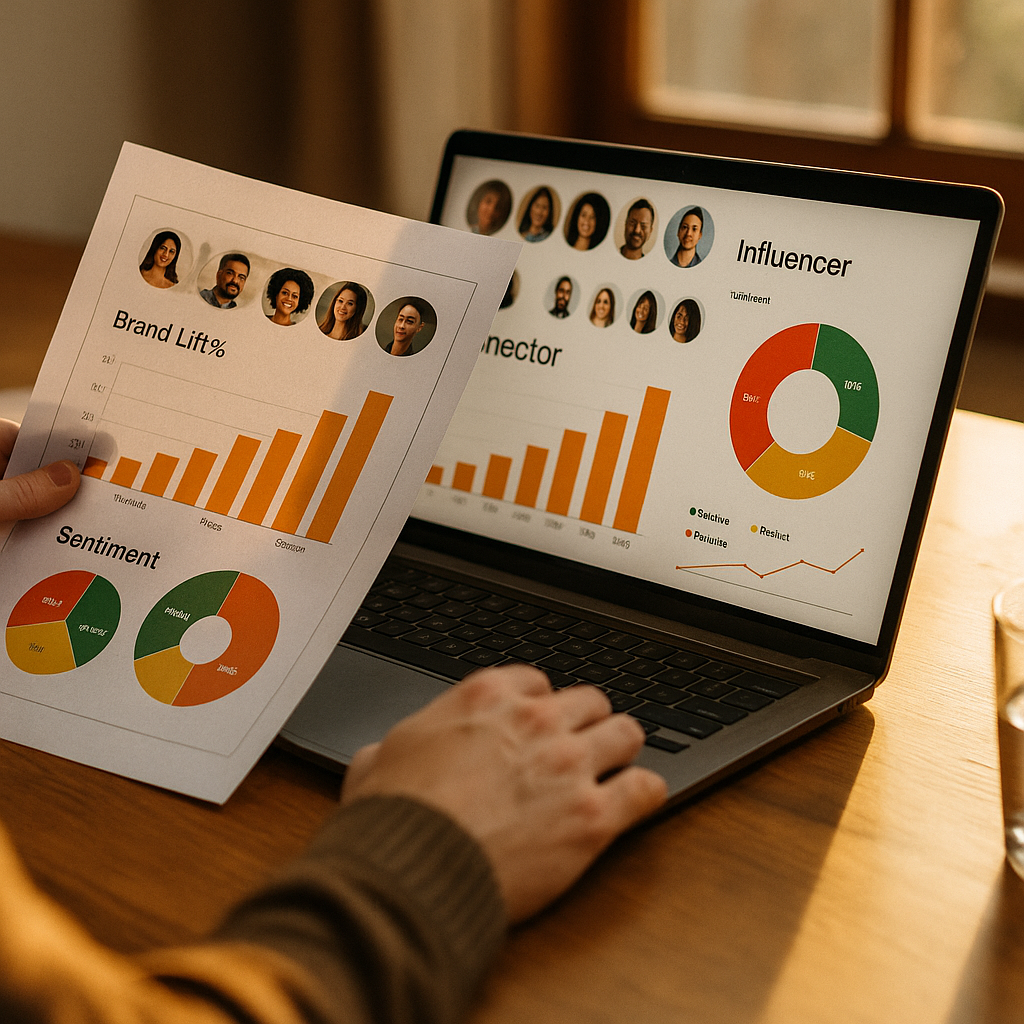Measuring influencer-driven brand lift and sentiment is critical for marketers eager to prove ROI and maximize campaign impact. This guide unpacks how to report on influencer-driven brand lift and sentiment with actionable strategies and trusted tools. Ready to showcase campaign success and optimize your influencer partnerships? Dive in below.
Understanding Influencer Impact: Why Measure Brand Lift & Sentiment?
Brand lift refers to the measurable positive impact on consumer attitudes and perceptions after exposure to influencer campaigns. Sentiment analysis, on the other hand, gauges how audiences feel about your brand—positive, negative, or neutral. In today’s saturated social environment, knowing these metrics helps marketers:
- Quantify the value of influencer collaborations
- Demonstrate ROI to stakeholders
- Identify which creators drive favorable perceptions
- Pinpoint areas for campaign improvement
Recent studies reinforce that brands investing in systematic measurement witness up to a 28% increase in campaign ROI. Fact-based reporting on influencer impact is no longer optional—it’s essential.
Key Metrics for Brand Lift Reporting in Influencer Marketing
To accurately assess influencer-driven brand lift, prioritize metrics that reflect changes in brand awareness, consideration, and purchase intent. Top metrics to include are:
- Brand Awareness: Track unaided and aided brand recall through pre- and post-campaign surveys.
- Brand Favorability: Measure shifting opinions with sentiment ratings and social mentions analysis.
- Purchase Intent: Use survey data and click-through rates to understand conversion pathway changes.
- Share of Voice: Analyze how much of the overall industry conversation your brand commands post-campaign.
- Earned Media Value (EMV): Calculate the monetary worth of influencer-generated coverage compared to paid ads.
These quantifiable KPIs provide a multi-layered view, helping marketers correlate influencer activity with actual business outcomes.
Best Practices for Sentiment Analysis in Influencer Campaigns
Understanding online sentiment helps brands respond strategically and build stronger communities. For influencer campaigns in 2025, apply these best practices for robust sentiment analysis:
- Contextual Evaluation: Go beyond surface-level keyword tracking. Use advanced AI-powered platforms to detect context and sarcasm in user posts and comments.
- Channel-Specific Tracking: Analyze sentiment across all relevant channels—Instagram, TikTok, YouTube, and emerging platforms—for complete insights.
- Combined Human & Automated Review: Blend AI efficiencies with manual checks, especially for nuanced influencer-driven campaigns where emotion runs high.
- Benchmarking: Set a pre-influencer sentiment baseline to measure real change after the campaign.
Remember that a single viral post or negative backlash can rapidly shift sentiment. Monitoring in real time allows brands to address issues as they arise and uncover valuable feedback.
Top Tools & Platforms for Reporting on Influencer Brand Lift and Sentiment
In 2025, advanced analytics tools automate much of the reporting process—saving precious time and enhancing data accuracy. The best influencer campaign analytics platforms typically offer:
- Automated brand lift surveys integrated with influencer content
- Real-time sentiment dashboards using natural language processing
- Influencer performance benchmarking
- Cross-platform reporting for unified campaign measurement
Leading platforms such as Brandwatch, Sprout Social, and CreatorIQ have evolved to offer dedicated modules for influencer impact analysis. Choose a solution that lets you customize reports and visualizations to align with campaign objectives and stakeholder needs. Always consider data privacy compliance when collecting audience feedback and using AI-driven sentiment tools.
How to Structure a Compelling Brand Lift & Sentiment Report
Building a clear, actionable report ensures stakeholders recognize the true value of influencer programs. Here’s how to craft a report that translates complex data into strategic insights:
- Executive Summary: Start with topline results—improvement percentages in awareness, favorability, and sentiment change.
- Methodology: Describe the data collection methods, including surveys and sentiment analysis tools, for EEAT transparency.
- Before & After Comparison: Use charts or graphics to visualize metric shifts from pre- to post-campaign.
- Qualitative Highlights: Share influencer content examples and notable user testimonials that signal changing sentiment.
- Recommendations: End with clear next steps, optimization tips, and proposals for scaling high-performing influencer partnerships.
For best results, use plain language and avoid jargon. Stakeholders should leave your report empowered to make informed decisions for the next phase of their influencer marketing journey.
Driving Continuous Improvement: Optimizing Influencer Campaigns with Data
Effective reporting is a springboard for iterative growth. Use brand lift and sentiment insights to refine targeting, messaging, and platform selection. Regularly:
- Test different influencer personas and content formats to compare brand lift results
- Run mini-surveys throughout the campaign for mid-flight adjustments
- Apply learning to brief creators for future campaigns, enhancing authenticity and resonance
- Share findings across marketing and product teams to foster a data-driven culture
By establishing a feedback loop powered by real-world results, brands continually raise the bar for influencer-driven brand affinity and advocacy.
FAQs: Influencer Brand Lift and Sentiment Reporting
-
What is influencer-driven brand lift?
Influencer-driven brand lift refers to measurable improvements in brand awareness, favorability, or purchase intent resulting from an influencer marketing campaign. -
How do you measure brand sentiment after an influencer campaign?
Use AI-powered analytics tools and manual reviews to analyze social mentions, comments, and survey responses, classifying feedback as positive, negative, or neutral before and after your campaign. -
What’s the difference between brand lift and sentiment?
Brand lift quantifies the change in consumer attitudes or intent, while sentiment analysis evaluates the positivity or negativity of consumer perceptions toward your brand. -
Which platforms help report on influencer campaign impact?
Popular platforms in 2025 include Brandwatch, Sprout Social, and CreatorIQ, each offering dedicated features for measuring brand lift and sentiment linked to influencer campaigns. -
How often should brands report on influencer impact?
Best practice is to report after each campaign, but also monitor results in real time and run periodic surveys during longer campaigns for more timely insights.
Accurate reporting on influencer-driven brand lift and sentiment is key to justifying and refining your influencer marketing strategy. Embrace the right metrics, tools, and communication techniques to ensure your campaigns deliver measurable, meaningful impact in 2025 and beyond.
